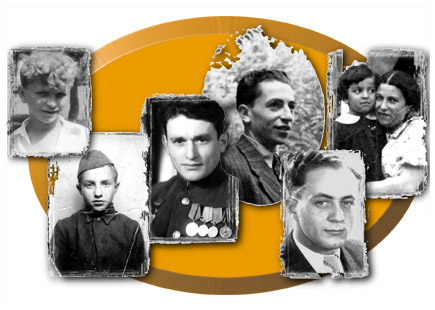Click on each photo to read the survivor's story.
Introduction
In April of 1942, just weeks before he was deported from the Warsaw ghetto to the gas chambers and ovens of Treblinka, Chaim Kaplan wrote in his diary, "When my life ends, what will become of my diary? Will they know about us and our experience? Will anyone remember or care?"
It is precisely to ensure that we do remember and care that Alvin Abram has written this remarkable book. Here are the stories of seven Holocaust survivors, who, through dogged determination, staggering courage and sheer luck, withstood the dark years of Nazi barbarism and came to Canada to build new lives for themselves and their families. These are stories of horror and hope, of terror and triumph. Above all, these are stories of inspiration, of the indomitability of the human spirit and of the refusal to surrender to the cruelties of that dreadful moment in human history. Rather, they fought back with vigour and creativity to preserve both their lives and their Jewishness.
It is a magnificent tribute to these men and women - Zalman (Eugene) Katz, Michael Kutz, Moishe Perlmutter, Dubi Arie, Marjan (Michael) Rosenberg and Batia and Feiga Schmidt (Batia Malamud and Faigie Libman) - that they came forward to share their stories with Alvin Abram, and through him, with the rest of us. These stories are difficult to read; how much more difficult they must have been to tell. And yet as these survivors know, it was imperative to give voice to their memories. Holocaust survivors are the living link to a vanished history that we can never recapture or recreate, and their stories are building blocks to a revitalized Jewish past. In the battle over the years to ensure Jewish survival and continuity, memory is the most important weapon in the Jewish arsenal.
For the men and women whose experience Alvin Abram describes, indeed for all survivors, silence would have been a tempting option, especially since language is inadequate to convey what they went through. Yet they chose to step out of the protective shadow of silence, even though it might have been the only adequate response to the horror beyond comprehension, because they knew they had to tell the world what happened. Their continued silence, and the silence of other survivors, would have merely consigned the six million victims to oblivion and their murders to greater meaninglessness. Only these memories can salvage some meaning from the ashes of Treblinka.
The trauma of the Holocaust is unparalleled in history. While generations to come may not remain as focused on it as we are today, it will always be a central historic and religious point for Jews. Their understanding of this human disaster will depend largely on the testimony of the survivors of our generation. For them, indeed for all humanity, the most compelling obligation is that we not forget, that we refuse to bury the past and encourage the survivor to speak loudly and publicly.
As well, the minority of the survivors will help defuse and uproot the hatemongers and the Holocaust-deniers in our midst who spread their venom throughout society. Holocaust denial is to the anti-Semitism of the 1990s what Zionism was to the anti-Semitism of the 1970s and 1980s. It is the organizing metaphor of the new and frightening anti-Jewish movements of this decade. This is why books such as The Light After the Dark are so profoundly important. The first-hand recollections and testimony of Holocaust survivors are the antidote of the poison of Holocaust deniers. They will help undermine those malevolent polemicists who claim that there were no death camps, no deportations, no gas chambers, no crematoriums, no Anne Frank, no Holocaust. And since there were no war crimes, that there were no war criminals, that the Holocaust was a hoax perpetuated on a gullible world by Jews anxious for monetary compensation and moral support to create the State of Israel.
The Nazis taught us one thing: that lies that go unchallenged become mistaken for truths; they become policies and ultimately they become murders. Of all the organs in the body, Jewish sages warned us, the tongue is by far the most dangerous. But it can also be the most liberating and illuminating, at least for those who use it to tell the truth. And that is what Alvin Abram and his collaborators have done. They have told the truth; they have vividly revealed their most painful secrets so that we may learn from them.
In commemorating the Holocaust, we should remember not only the too-familiar pictures of starving, skeletal Jews behind ghetto walls and barbed wire, photographs taken by murderers themselves, the Nazis, to demonstrate the helplessness, sub-human quality of those they were killing. Of course we know the pictures are real; they are scored in our minds and our hearts. But we also know that they present only one part of what went on under the Nazis.
Before hunger, deprivation, terror and torture there was another part of life - life filled with meaning, spirituality, dignity, resistance and struggle, and even in the blackest moment in the history of the Jewish people the enemy could not vanquish this spirit.
That is the message of this powerful, moving book, a message we must never forget.
IRVING ABELLA
Co-author of None Is Too Many: Canada and the Jews of Europe 1933-1948
with Harold Troper
